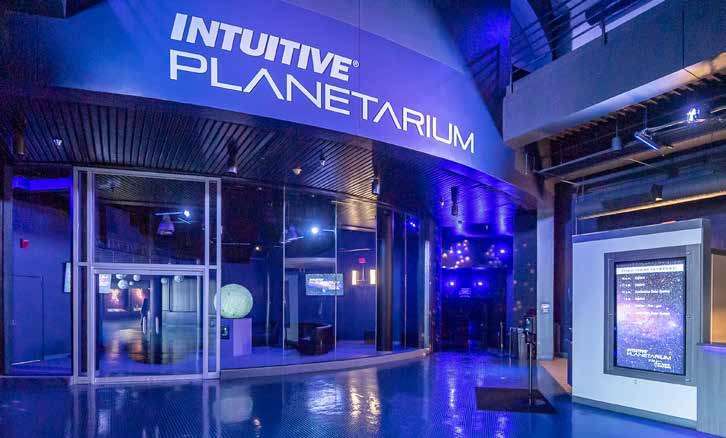US Space & Rocket Center’s new INTUITIVE Planetarium
by Judith Rubin
ABOVE: Entrance to the INTUITIVE Planetarium Image courtesy of USSRC
“Huntsville deserves a world-class planetarium,” said U.S. Space & Rocket Center (USSRC) CEO and Executive Director Deborah Barnhart at the ribbon cutting for the new, 248-seat INTUITIVE® Planetarium on Feb 28, 2019. And now they’ve got one.
Named for its investor – local aerospace engineering and analysis firm Intuitive Research and Technology Corporation – the new planetarium takes USSRC from analog to cutting-edge digital, and from film dome to fulldome. By virtue of the custom technology package featuring five brand-new Christie D4K40-RGB laser projectors supplied by Evans & Sutherland (E&S), this venue is a pioneering example of RGB laser projection in planetariums, a new standard-setter in many ways and for multiple markets.
“We hope everybody will go and see this installation to witness the astonishing capability of these projectors and this system,” said Doug Boyer, senior account manager at Christie, specializing in custom solution development for immersive systems including giant screen, dome theaters, and 3D visualization centers. Since its rollout the Christie D4K40-RGB projector has been singled out for high marks and multiple awards in the AV community with respect to color, brightness, versatility and form factor. RGB laser projection technology, also called true or pure laser, uses individual Red, Green and Blue lasers to generate ideal light. This is unlike the more commonly known laser phosphor projectors, and key to the ability of RGB laser projection to deliver the expanded color gamut known as Rec. 2020 (explained in more detail below). “At the INTUITIVE planetarium, they’re learning to take full advantage of all these colors – making it possible for audiences to see deeper into the cosmos, to see things that were not visible before,” said Boyer.
“The images on the screen are sharper than a knife – the black sky of the Milky Way providing a brilliant backdrop to the colorful Earth,” wrote Paul Gattis, who attended and reported on the opening for AL.com.
E&S quickly snapped up 10 of the new projectors: five to install at its corporate headquarters in Salt Lake City for planetarium and dome cinema demonstrations, and five for the USSRC installation, an E&S ESX 8K system that integrates the Christie projectors with Digistar 6 and a Spitz Nanoseam™ screen to fill the entirety of the planetarium’s 67-foot diameter, 30-degree tilt dome. “Together with our world-class alignment and blending system, the image looks stunning. We are excited to be the first to offer this powerful new Christie RGB laser technology to the market,” said Kirk Johnson, President and COO, Evans & Sutherland.
According to Johnson, the relationship between E&S and the USSRC developed through participation at various conferences for the planetarium and giant screen sectors organized by IPS, IMERSA, GSCA and others. E&S and Christie often collaborate to provide the industry with opportunities to see their products and systems in action, and in the past five years this has included demonstrations and comparison shootouts at the Science Museum of Virginia, Richmond (2014); The Tech Museum, San Jose (2015); Ontario Science Centre, Toronto (2016) and McWane Science Center in Birmingham, AL (2018). “These demonstrations illustrated how the ESX and Digistar systems could be utilized to fulfill the USSRC’s mission,” said Johnson.
Once the Rocket Center was ready for bids, things moved quickly. “We began the bidding process in January of 2018 and signed in May,” said Johnson. “The dome installation was completed in December of 2018, and system install was in February, followed not long after by the grand opening.”
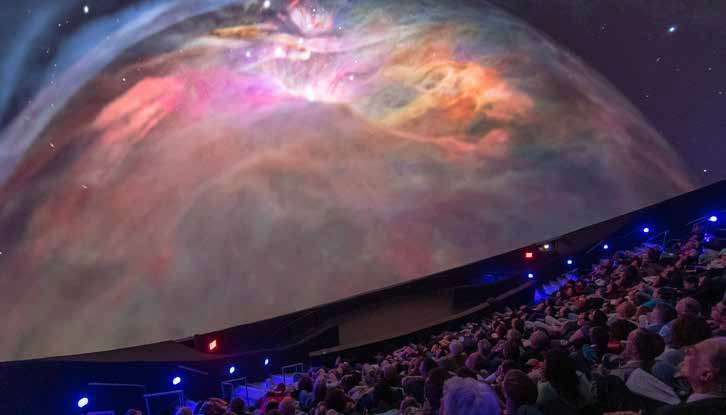
Replacing giant-screen film systems
As digital dome projection systems continue to improve, they find more applications. In addition to planetarium upgrades they are increasingly embraced by themed entertainment operators for immersive, media-based experiences, and by museum and science center operators as a versatile replacement for aging giant-screen film dome systems. E&S has actively worked to fill the latter need, with many successes, many of which use Christie projectors. The INTUITIVE Planetarium is one of the newest examples.
Journalist David Hitt summarized it aptly in his report on the new planetarium for Huntsville.org. “…the Rocket Center’s Spacedome IMAX theater…was state-of-the-art itself when it opened more than three decades ago. It had its own impressive bit of technology – a 70mm projector that went on to be one of the last of its kind. Visiting the IMAX theater for classic space movies like “Hail Columbia” and “The Dream Is Alive” was a rite of passage for generations of students in Alabama and beyond. It would take something special indeed to live up to that legacy. The INTUITIVE® Planetarium is up for the task.”
“The U.S. Space & Rocket Center wanted to replace their aging partial dome 1570 film solution with a top-of-the-line 8K digital system,” said Johnson. “E&S designed, engineered and integrated the system in their facility, as well as provides training and ongoing support to help USSRC bring astronomy and science education to audiences of all ages.”
Of the many benefits cited for the new system, a very noticeable one is reclaiming the sweet spot for audience use. The five new projectors are installed in a ring overhead, replacing the single, massive film projector that formerly sat in the middle of the auditorium. As Johnson said, “One benefit of the redesign was the ability to add premium quality seats in the center of the theater after the IMAX projector was removed.”
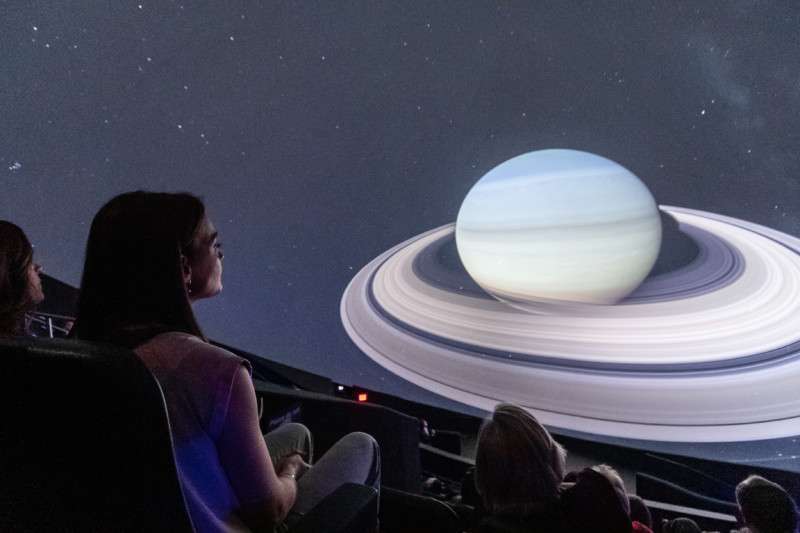
Projector bragging rights
Christie has rolled out two models representing its second generation of RGB laser technology: the Mirage SST and D4K40-RGB. These are the result of considerable market research and R&D aimed at raising the bar, in many respects designed to appeal to large venues, planetariums and domes. The D4K40-RGB is the all-in-one model installed at USSRC whereas the Mirage SST has a more compact head and remote light source. The product literature touts 40,000 lumens; all-in-one, energy efficient design; long lifespan and minimal maintenance; small form factor with no external chillers; optimal illumination performance of 20,000 hours to 60% brightness, 5000:1 contrast ratio, frame rate up to 120 fps; new, patented, sealed optical path; operating on single-phase 220V power and ability to deliver more than 95% of the Rec. 2020 color space.
“From a user standpoint, the difference in color performance is very noticeable,” said David Weigel, USSRC Planetarium Director. “You can pick out every single star in a star cluster. I have noticed that the color range on the screen can’t be quite reproduced in photos – people’s everyday cameras don’t have the same range as these projectors.”
Along with color, there are brightness and uniformity. Said Johnson: “The combined brightness of the five projectors off the Spitz NanoSeam was measured by our technicians at 4.5 foot-lamberts. This brightness is uniform across the entire dome image. The system brightness does not drop off nearly 50% towards the edges like a traditional film or single digital projection system does.”
“The projectors are amazing,” said Weigel. “The depth and vibrancy of color and the clarity they provide are fantastic. The image is super bright, and yet the contrast is great. The brightness is to the point where people can take flash photography and it doesn’t ruin the experience for others. We can fully light the stage for special events and you really don’t lose that much on the dome at all because of the super bright projection,” adding that “the surround sound system can really rock the house.”
Johnson said, “E&S works closely with Christie as they develop new projector technology. We not only have relationships with the sales team, but we maintain relationships with Christie engineering and product management and service. This close working relationship enabled us to offer brand-new technology right off the production line and into USSRC’s theater.”
“E&S is very hands-on and knowledgeable, especially in the planetarium space,” said Boyer. “Because it was a new product, prior to this install there was a lot of education up front, a lot of conversation between Christie’s project manager and the E&S tech team, as well as training on laser safety. This product is based on our TruLife electronics platform, and E&S is very familiar with that and how to interface it with the Digistar 6 configuration.”
The compact form factor, omni-directional function and lampless, solid-state construction are all held up as significant benefits to installation and operations, by supporting nonstandard mounting positions (within laser safety guidelines). That can be a critical factor for new construction as well as a retrofit. Larry Howard, Director of Sales, Entertainment at Christie said, “The optimal positions for mounting projectors in a planetarium are sometimes very steep, odd angles. That’s no problem at all with the D4K40-RGB.” Software tools, he points out, have eliminated the issues of blending and alignment that used to raise concerns about replacing one projector with several and mounting them at odd angles.
Boyer said, “Some projectors on the market can’t tilt over a certain degree. If you tilt a xenon bulb past eight degrees, you will start seeing flicker from the lamp trying to maintain the arc. The D4K40-RGB is designed to be used at any angle or tilt, landscape or portrait mode.”
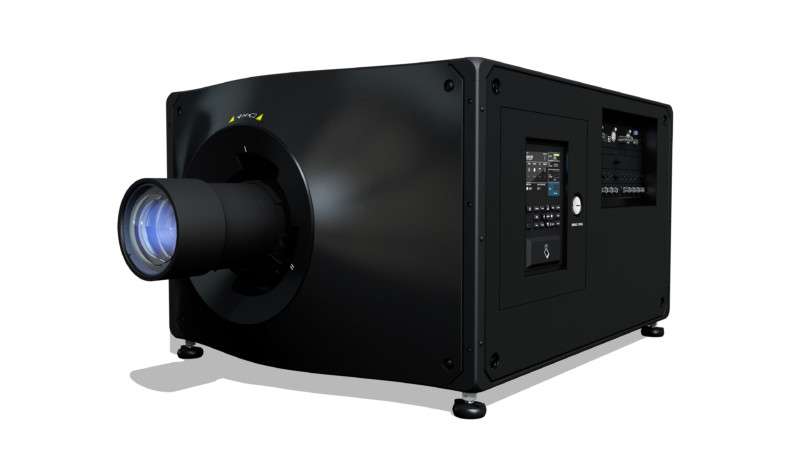
The conversation on color and cross-reflection
Christie is keen for users to understand the leap in color capability facilitated by RGB laser and has published resources online, including the white paper by color scientist and entertainment specialist Matt Cowan, co-founder of Entertainment Technology Consultants, available at www.christiedigital.com/techpapers/rec2020-whitepaper.pdf and a free e-book, “Illuminating ProAV” available at christiedigital.com/illuminationguide. Christie also hosts color demo shootouts for first-hand, real-life comparison viewing of three color gamuts: Rec. 2020 (facilitated by RGB laser) vs Rec. 709 (associated with HDTV) and P3 (associated with DCI, the Digital Cinema Initiative).
Cowan describes Rec. 2020 as a superior color space in terms of representing the real world and achieving precise color matches that can reproduce colors not possible with Rec. 709 or P3. He writes, “Rec. 2020 color provides the opportunity to display a better representation of real-world colors than the commonly used color spaces for television and cinema. The standards committee for Rec. 2020 chose color primary coordinates that are at the extreme edge of the visible color space…RGB laser illuminated projectors are ideal for achieving this.”
RGB laser projection can deliver this expanded color space, but laser phosphor projection cannot. Both are lampless projection technologies; the key difference is how the light is produced. Laser phosphor uses blue laser diodes as the primary light source, generating the three primary colors by shining the blue light of the diodes onto a spinning wheel coated in a phosphor compound. The blue light excites the phosphor, emitting yellow light; dichroic coatings are used to further segment the colors.
RGB laser is lamp-free, wheel-free and solid state. It employs individual red, green and blue laser diodes as its light source, and they are scalable. The scalability supports ever increasing levels of brightness and the individual, primary color diodes support the Rec. 2020 color palette.
A longtime bane of dome projection is cross-reflection. The concern that brightness will create cross-reflection in a dome theater often leads to specifying projectors of relatively low lumen output. This assumption is being challenged. “Based on extensive testing done using Christie projectors in contemporary dome environments, we are comfortable with higher brightness in today’s planetarium settings,” said Howard. “Thanks to new technology, we can set aside some of the old specs from decades ago and stop dancing around cross reflection.”
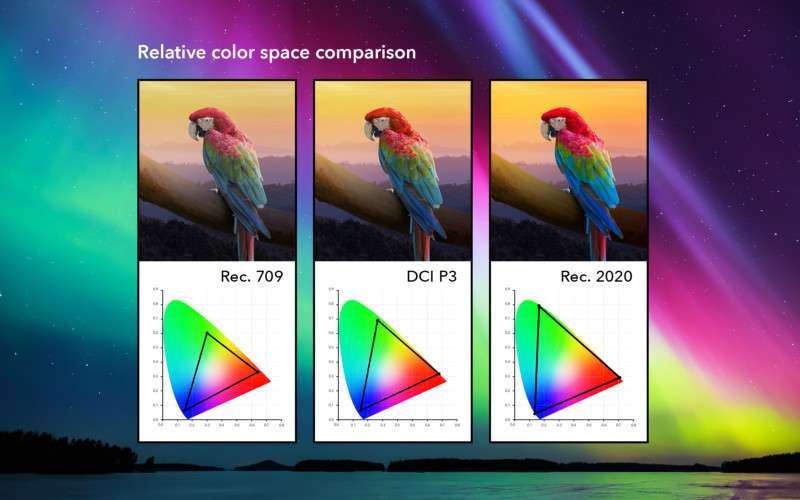
Loving it live
Weigel’s approach to planetarium programming emphasizes real-time, in-house custom content and audience participation and reflects his own, palpable enthusiasm for astronomy and space science. “Live shows connect with audiences in a way other programming can’t,” he said. “I try to engage with the audience as much as possible. We want to give them something high end, but also to keep things current and cutting edge – an experience that is welcoming, engaging, entertaining and educational without feeling like a lecture or a tour guide. We’re all in it together, on the journey through the cosmos, learning and sharing the excitement, being wowed by the sheer awesomeness of the universe.”
In the months since opening, Weigel has been on a journey through the Digistar 6 universe of tools and resources to produce a steady stream of live shows, while also dipping into libraries of pre-rendered shows for fulldome exhibition.
Enumerating some key features, Johnson said, “Digistar combines image quality, simulation power and ease of use. Planetarium shows can be developed quickly and seamlessly with the Digistar 6 show builder. Users have access to comprehensive and frequently updated astronomy data and can share content in the Digistar Cloud. There is also an extensive library of science and STEAM content, connectivity to live scientific data feeds and support for 3D and virtual reality.”
Weigel’s experience with Digistar 6 would bear out Johnson’s description. Weigel’s first day on the job as INTUITIVE Planetarium director was Feb 27, 2019 – one day before the ribbon cutting. He brought with him a wealth of experience using World Wide Telescope but only limited acquaintance with Digistar. Nevertheless, on Feb 28 there he was – creditably and confidently enough – demonstrating Digistar 6 to a VIP audience. “We flew live with an X-box controller and did a brief tour of leaving the Earth and going to the Moon, and it was very well received.”
Weigel brought in some new presenters and content creators, and trained some of the existing staff, adding up to a core staff of five fulltime people plus several part-time. “Every single Friday we have a unique presentation that we’ve basically been working on for the week,” he said. “Evening programming is almost exclusively our own content. Thanks to Digistar and the amazing new projectors, the visuals we are presenting are stunning.”
Along with its investment in the planetarium, INTUITIVE ® (the company) is the Apollo 50th Golden Anniversary Sponsor for all U.S. Space & Rocket Center anniversary activities. At this writing, programming celebrating the 50th anniversary of Apollo 11 and the moon landing was fully underway, including a distinguished panel presentation with Apollo-era scientists and engineers, moderated by Weigel, who is clearly loving his profession. “It’s a neat thing to be a part of and a ton of fun.”
“This is the finest investment INTUITIVE could have made in our community for space education,” said Dr. Barnhart. “This is an investment for decades to come.” • • •


